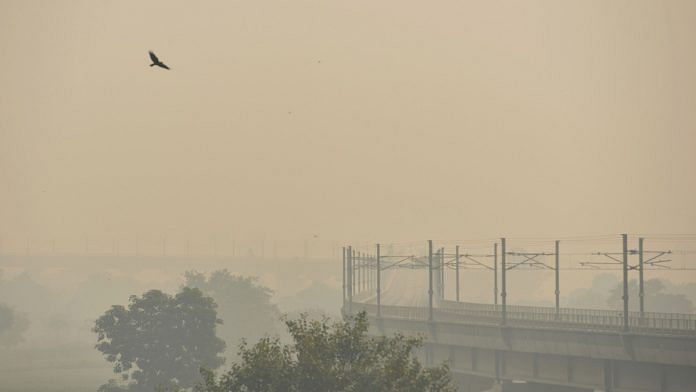New Delhi: Delhi had anticipated the season’s worst pollution levels on the morning after Diwali, but the air quality, although “very poor”, turned out better than the last three years, according to data of the government’s air quality monitors.
The Ministry of Earth Sciences’ air quality monitoring service, SAFAR, had earlier predicted that the city’s overall air quality index (AQI) would enter the “severe” category between 1 am and 6 am on Monday, primarily due to firecracker emissions, unfavourable weather and a significant spike in stubble burning.
But, Delhi sprung a surprise with air quality sensors recording only a marginal increase in pollution levels even though people continued bursting crackers until late on Sunday night, violating the Supreme Court-enforced two-hour limit with impunity.
While the city’s AQI stood at 327 at 11 pm. It dipped to 323 at 3.30 am, just about when it was expected to enter the “severe” category.
It, however, increased to 340 at 8:30 am, as the weather department reported occurrence of shallow fog.
An AQI between 0-50 is considered “good”, 51-100 “satisfactory”, 101-200 “moderate”, 201-300 “poor”, 301-400 “very poor”, and 401-500 “severe”. Above 500 is “severe-plus emergency” category.
Thirty-six of the 37 air quality monitoring stations in the capital recorded their AQI in “very poor” category.
Delhi’s air quality was, however, better than satellite towns of Ghaziabad (375), Greater Noida (356), Gurgaon (352) and Noida (375), according to Central Pollution Control Board’s data.
Last night, people reported violation of the two-hour window in Malviya Nagar, Lajpat Nagar, Kailash Hills, Burari, Jangpura, Shahdara, Laxmi Nagar, Mayur Vihar, Sarita Vihar, Hari Nagar, New Friends Colony, Hauz Khas, Gautam Nagar, Dwarka among others places.
Residents in Noida, Gurgaon, Ghaziabad also reported extensive fireworks much beyond the timeframe.
People could also be seen bursting crackers before 8 PM, however, the intensity remained low.
The levels of PM10 tiny particulate matter of diameter 10 or less than 10 microns that can enter deep into the lungs had on Sunday reached as high as 515 micrograms per cubic metre in Anand Vihar.
In Wazirpur and Bawana, PM 2.5 levels had crossed the 400 mark.
After last year’s Diwali, Delhi’s AQI had crossed the 600-mark, which is 12 times the safe limit. The AQI post-Diwali was 367 in 2017 and 425 in 2016.
With Delhi’s air quality plummeting to dangerous levels around Diwali every year, the Supreme Court in 2018 banned polluting firecrackers and ordered that only green firecrackers, which is said to cause 30 per cent less pollution, can be manufactured and sold.
But the green pyrotechnics have failed to draw good response both from sellers and buyers, primarily due to lack of variety, limited stock and high prices.
Last year also, people continued to buy the conventional firecrackers and use them.
Also read: 64% people in Delhi-NCR say they won’t burst crackers this Diwali, finds survey



